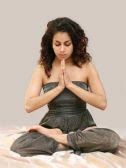
By Dr. Paul Jerard, E-RYT 500
In Yoga, and Ayurveda, the Yogic body is composed of three bodies. One is the physical body (sthula sharira), which we can easily see. Another is the causal body (karana sharira), which we often refer to as the soul.
The energy body (sukshma sharira), is often called the subtle, vital, or Pranic body. This is very often a mystery to many, and confusing to more, but let’s take a tour of the energy body and you will understand it much better.
If someone does not believe in the existence of the energy body - I would ask how the physical body runs without electricity. Without electricity, we would have heart failure, and very big problems, if our hearts are not restarted.
How is the heart restarted? Sometimes CPR is enough, but most often CPR helps just long enough for a defibrillator to be used to restart the heart. The defibrillator causes low voltage electric current to enter the body through paddles or patches, which are then applied to the chest.
At the atomic level, your body is full of electrons, flying all over the place, and some are flying around the body. We cannot see it, but we know it is happening. How is this? We have faith in science, but science cannot measure everything.
For centuries, Ayurvedic doctors, and doctors of Chinese medicine, mentioned the electro-magnetic body, but western medicine scoffed at the idea of it. How could there be energy meridians? Does acupuncture really work or is it a “side show?” How come the energy meridians of Chinese medicine line up with the Nadis of Ayurvedic medicine?
Time has passed, and western medicine has now started to work in harmony with Ayurveda and Chinese medicine. Maybe there’s something to the Yogic energy body after all. So, what are the main parts of the Yogic energy body?
Nadis (Energy Meridians): There are 72,000 Nadis in the electro-magnetic body, which send vital energy (Prana) from one point to another. Shushumna, Ida, and Pingala are considered the most important to Yoga students - although, 14 main Nadis should covered, when this subject is covered during a Yoga teacher training intensive.
Marmas (Pressure or Energy Points): There are 107 Marmas, and some say 108, but they can be effectively treated for healing purposes. Unfortunately, they can also be considered strike points in martial arts, but these energy points correspond, regardless of the purpose.
Chakras (Energy Vortices): There are seven main chakras, which transform magnetic currents of the earth into energy of the physical body. This physical energy balances the central nervous system and the endocrine system. There are also many secondary and minor Chakras.
In Yoga, and Ayurveda, the Yogic body is composed of three bodies. One is the physical body (sthula sharira), which we can easily see. Another is the causal body (karana sharira), which we often refer to as the soul.
The energy body (sukshma sharira), is often called the subtle, vital, or Pranic body. This is very often a mystery to many, and confusing to more, but let’s take a tour of the energy body and you will understand it much better.
If someone does not believe in the existence of the energy body - I would ask how the physical body runs without electricity. Without electricity, we would have heart failure, and very big problems, if our hearts are not restarted.
How is the heart restarted? Sometimes CPR is enough, but most often CPR helps just long enough for a defibrillator to be used to restart the heart. The defibrillator causes low voltage electric current to enter the body through paddles or patches, which are then applied to the chest.
At the atomic level, your body is full of electrons, flying all over the place, and some are flying around the body. We cannot see it, but we know it is happening. How is this? We have faith in science, but science cannot measure everything.
For centuries, Ayurvedic doctors, and doctors of Chinese medicine, mentioned the electro-magnetic body, but western medicine scoffed at the idea of it. How could there be energy meridians? Does acupuncture really work or is it a “side show?” How come the energy meridians of Chinese medicine line up with the Nadis of Ayurvedic medicine?
Time has passed, and western medicine has now started to work in harmony with Ayurveda and Chinese medicine. Maybe there’s something to the Yogic energy body after all. So, what are the main parts of the Yogic energy body?
Nadis (Energy Meridians): There are 72,000 Nadis in the electro-magnetic body, which send vital energy (Prana) from one point to another. Shushumna, Ida, and Pingala are considered the most important to Yoga students - although, 14 main Nadis should covered, when this subject is covered during a Yoga teacher training intensive.
Marmas (Pressure or Energy Points): There are 107 Marmas, and some say 108, but they can be effectively treated for healing purposes. Unfortunately, they can also be considered strike points in martial arts, but these energy points correspond, regardless of the purpose.
Chakras (Energy Vortices): There are seven main chakras, which transform magnetic currents of the earth into energy of the physical body. This physical energy balances the central nervous system and the endocrine system. There are also many secondary and minor Chakras.
© Copyright - Aura Wellness Center – Publications Division
See our testimonials to find out what our graduates have to say about our selection of online teacher certification courses.
Please feel free to share our posts with your friends, colleagues, and favorite social media networks.









